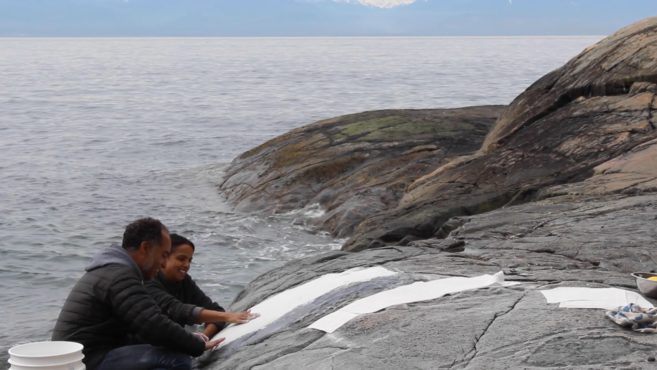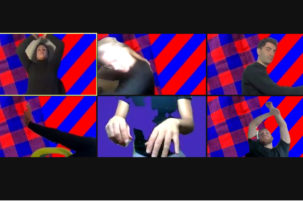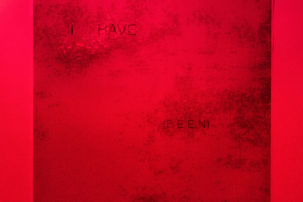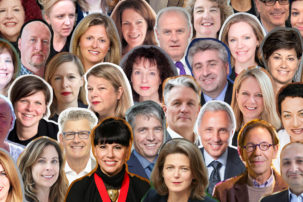In October 2018, I attended a talk entitled “Can I Get a Witness?” presented by the Art Gallery of Ontario’s new deputy director and chief curator Julian Cox for the Daniels Faculty Master of Visual Studies Proseminar series at the University of Toronto. British ex-pat Cox borrowed the title for the talk from a song of the same name made famous by Marvin Gaye. “Can I Get a Witness?” focused on Cox’s work on a 2008 exhibition at the High Museum of Art in Atlanta, Georgia, titled “Road to Freedom: Photographs of the Civil Rights Movement, 1956-1968.” Commentary about the exhibition describes it as the most comprehensive exhibition of photography of the American civil rights movement to date. At the beginning of his talk, Cox drew our attention to a particular line in the Marvin Gaye song: “Is it right to be treated so bad / When you’ve given everything you had?” thus drawing a correlation between the lamentation of a lovesick singer and the ongoing work of Black people for equal rights.
Cox flipped through images that had been part of the High Museum exhibition, including photographs showing a white man pouring acid into a desegregated pool; a Black reporter getting attacked with a brick by a white protester—injuring him so severely Cox noted, that the Black reporter incurred life-changing injuries; and a Black protester being pulled in different directions by his arms and legs by police officers. Cox cycled through the violent pictures, projected larger than life in the Daniels auditorium, and at one point used a laser pointer to compare the posture of a bloodied Black man in a Danny Lyon photograph to the composition of a classical painting.
I sat in the audience sweating, frantically reading emails on my phone, trying not to look up. My cousin had been shot and killed in New York a few weeks earlier, and I was distressed thinking about how the “art” talk I was currently attending was aestheticizing the violence that my family was currently experiencing. This wasn’t art, it was death. The slides were unrelenting, moments of incredible human pain frozen in time and supersized. Black pain, Black horror-as-spectacle, is nothing new, but it never gets easier to consume. Nothing about our experience was noble or poignant; how I felt was nothing like the lovesick lamentations of Marvin Gaye.
What’s the difference between a token and a relationship? What kinds of relationships are capable of surviving this period of austerity and uncertainty?
The violence depicted in this presentation was compounded by the fact that Cox was presenting a body of curatorial work that was 10 years old at the time of his talk. As a white British-born curator who had recently arrived at the AGO via the US, Cox seemed to have chosen this talk as a form of currency for gaining entrance to an art community with stated values around diversity and equitable practices. In other words, a white curator from Britain exchanged aestheticized violence against Black people for cultural capital in the Toronto art community. This exchange perpetuated extractive colonial practices, consuming Black bodies for Cox’s own advancement, which in this case depended on appearing race-aware and versed in issues of diversity.
What’s the difference between a token and a relationship? Reflecting on this talk two years later, sitting at home during this crisis, I have to ask myself: What kinds of relationships are capable of surviving this period of austerity and uncertainty? As a curator, Cox selected a 10-year-old body of work to dovetail the AGO’s exhibition programming that year (Kara Hamilton, Winsom and Mickalene Thomas). Running the laser pointer up and down photographs of hurting Black bodies throughout the presentation, Cox placed more emphasis on the composition of the graphic images he was presenting than the horror of the subject matter.
Part of what was so horrific was the lack of compassion from Cox. The horror of the subject matter is that the documents of the violence perpetrated against Black people are made pedestrian. I watched as a white curator presented images of Black pain without affect, and witnessed the horror of the complacency, the almost scientific objectivity, with which he discussed these images. This is similar to the horror of having to watch Ahmaud Arbery’s lynching video on my Instagram feed over and over, without warning and without reprieve. Experiencing apathy in the face of our pain, witnessing of the circulation of images of Black death by white hands—that is Black horror.
Our humanity is not being taken seriously. Organizations capitalize on the spectacle of Black death. Black people in Canada and America are deanimated and made into artifacts, objects of study in galleries that only are meant to represent suffering and death.
Cox made no effort to address the exhibition’s relationship to the current political climate that made these photographs not simply artifacts, but reflections of the ongoing and very real crisis of Black suffering and death. At several points throughout the talk, Cox highlighted the types of clothing Black protesters were wearing in the photographs: Black men marching in their Sunday suits, women in high heels. This was, Cox had learned, because the protesters wanted to be taken seriously. Afterwards, in the Q&A period, I asked a question about Cox’s emphasis on styles of dress, thinking of the death of Trayvon Martin, who was shot while wearing a hoodie: Shouldn’t we be safe no matter what we choose to wear?
Cox’s perspective on protest speaks to a greater insensitivity to Black life within the art world, one recently echoed in performative Black Lives Matters gestures (such as the black square solidarity statements) from institutions that don’t have many Black staff or artists in collections, and that house stolen objects from Africa. Our humanity is not being taken seriously. Organizations capitalize on the spectacle of Black death. Black people in Canada and America are deanimated and made into artifacts, objects of study in galleries that only are meant to represent suffering and death.
Still, there are many examples of how curatorial practice can drive institutional change. Toronto-based curator Emelie Chhangur has been working in alternative ways, with work that has taken several forms during her tenure at the Art Gallery at York University, which I witnessed first-hand during an internship in the summer of 2018. As stated in their mandate, the AGYU is committed to engaging with the Jane and Finch neighbourhood where the gallery is located, working with the predominantly Black and Brown youth in the area and opening up the gallery for youth-led organizations such as Jane Street Speaks and RISE (Reaching Intelligent Souls Everywhere) Edutainment. These relationships developed into a joint collaboration with Brazil-based artists Benjamin de Burca and Bárbara Wagner, who produced their acclaimed film RISE (2019) with Chhangur through a research residency and commission by the AGYU. One alternative to aestheticized violence as currency is building long-term community relationships. While some methods exchange images of suffering for personal gain, this kind of community work provides real forms of support, building long-term reciprocal relationships as well as developing opportunities for growth and mutual learning for artists, curators and audiences. With this work, Chhangur presents a feasible alternative to Black horror through the nurturing of strong foundations upon which artists of colour are able to present their work rather than having it instrumentalized by an institution as an optics decision.
What are the things that break in a crisis? What kinds of fault lines does a crisis reveal? We’re not going to get through this without each other, but we also won’t get through this by using each other. We need mutual support and community. We must ask ourselves, What can stretch or change shape? As the world changes, pre-existing relationships can evolve and grow to meet our needs. Institutional violence and the superficial use of identity politics is something we have a chance to do away with, as a result of this crisis. We are all witnesses to the use of weaponized identity politics, and by supporting the people and organizations who prioritize community-focused practices that consider real people and real needs, we can together make every institution drop the gun.

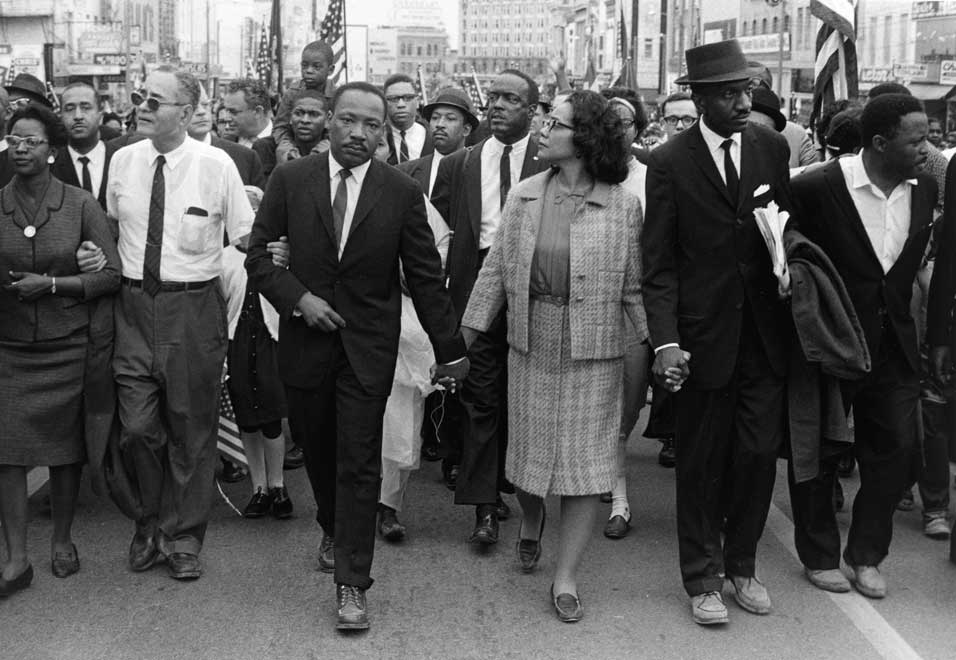 March To Montgomery. Dr. Martin Luther King, Jr. arrives in Montgomery, Alabama on March 25,
1965, at the culmination of the Selma to Montgomery March. Pictured, from
left: Ralph Bunche, Dr. Martin Luther King, Jr., Coretta Scott King,
Rev. Fred Shuttlesworth, Hosea Williams. Photo: Morton Broffman/Getty
Images
March To Montgomery. Dr. Martin Luther King, Jr. arrives in Montgomery, Alabama on March 25,
1965, at the culmination of the Selma to Montgomery March. Pictured, from
left: Ralph Bunche, Dr. Martin Luther King, Jr., Coretta Scott King,
Rev. Fred Shuttlesworth, Hosea Williams. Photo: Morton Broffman/Getty
Images
